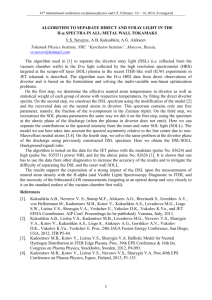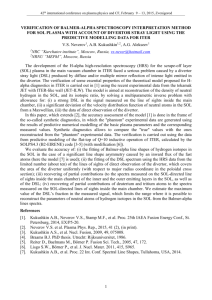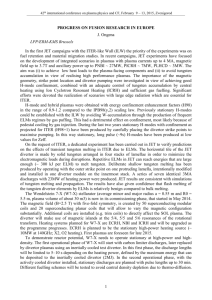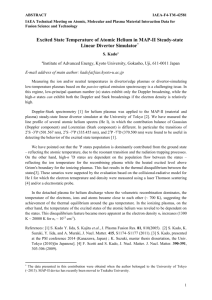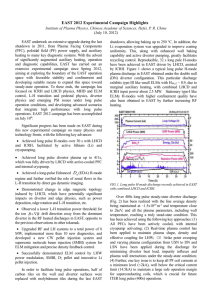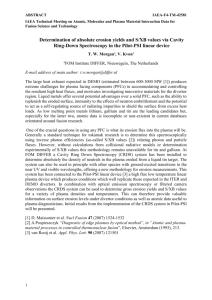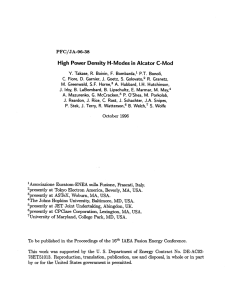High-Field Compact Divertor Tokamak Research on Alcator C-Mod
advertisement
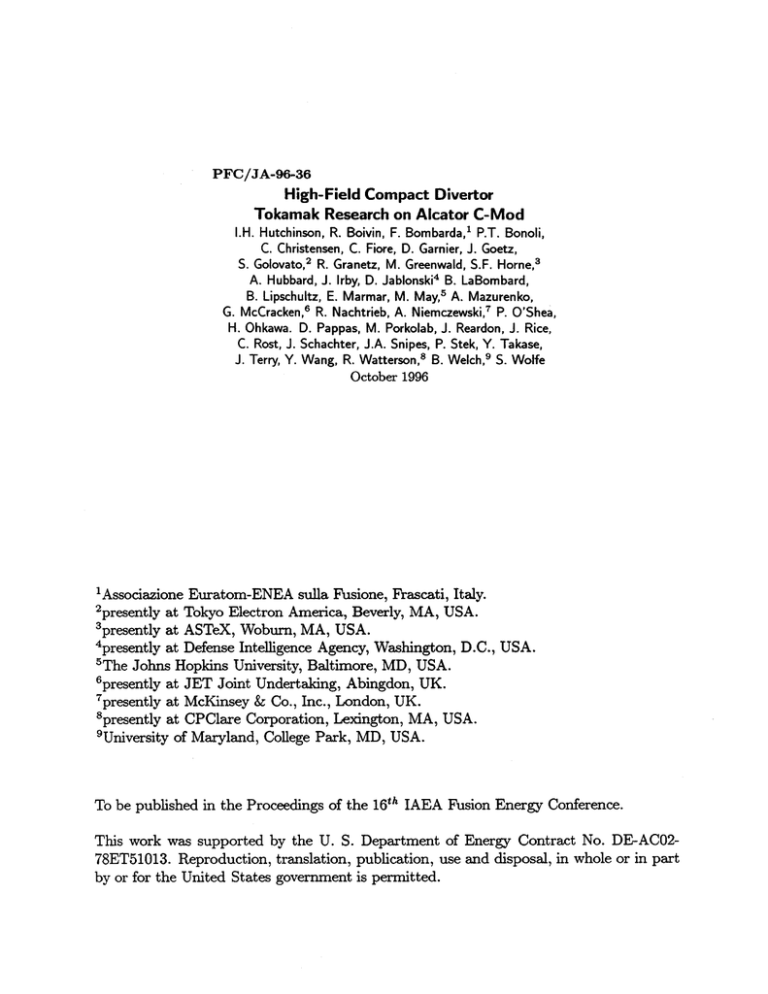
PFC/JA-96-36 High-Field Compact Divertor Tokamak Research on Alcator C-Mod l.H. Hutchinson, R. Boivin, F. Bombarda, 1 P.T. Bonoli, C. Christensen, C. Fiore, D. Garnier, J. Goetz, S. Golovato, 2 R. Granetz, M. Greenwald, S.F. Horne,' A. Hubbard, J. Irby, D. Jablonski' B. LaBombard, B. Lipschultz, E. Marmar, M. May,' A. Mazurenko, G. McCracken, 6 R. Nachtrieb, A. Niemczewski, 7 P. O'Shea, H. Ohkawa. D. Pappas, M. Porkolab, J. Reardon, J. Rice, C. Rost, J. Schachter, J.A. Snipes, P. Stek, Y. Takase, J. Terry, Y. Wang, R. Watterson, 8 B. Welch, 9 S. Wolfe October 1996 'Associazione Euratom-ENEA sulla Fusione, Frascati, Italy. 2presently at Tokyo Electron America, Beverly, MA, USA. 3 presently at ASTeX, Woburn, MA, USA. 4presently at Defense Intelligence Agency, Washington, D.C., USA. -The Johns Hopkins University, Baltimore, MD, USA. 6 presently at JET Joint Undertaking, Abingdon, UK. 7 presently at McKinsey & Co., Inc., London, UK. 8presently at CPClare Corporation, Lexington, MA, USA. 9 University of Maryland, College Park, MD, USA. To be published in the Proceedings of the 16 th IAEA Fusion Energy Conference. This work was supported by the U. S. Department of Energy Contract No. DE-AC0278ET51013. Reproduction, translation, publication, use and disposal, in whole or in part by or for the United States government is permitted. F1-CN-64/02-3 HIGH-FIELD COMPACT DIVERTOR TOKAMAK RESEARCH ON ALCATOR C-MOD ABSTRACT Alcator C-Mod has demonstrated H-mode confinement that exceeds recent empirical H-mode scalings by a factor of 1.5. A new type of ELM behavior has been observed that avoids high instantaneous heat outflux. The compact, highfield plasmas obtained have enabled divertor studies to be performed at parallel power fluxes close to those predicted for ITER. Detached-divertor H-modes have been obtained by nitrogen puffing. Very high divertor neutral pressures are observed, which persist into the detached state. Highlights of these and other recent experimental results are presented. 1. INTRODUCTION The Alcator C-Mod tokamak [1] (R = 0.67 m, a = 0.21 m, r, i 1.85) pro- duces high-field, compact, high performance plasmas. The research program is focussed on using this capability to explore plasmas with unique dimensional parameters but at dimensionless parameters comparable to those of much larger fusion experiments. Through comparisons with these other experiments, Alcator thereby provides critical scientific tests of physics scaling and theoretical understanding. In addition, the high power-densities achievable allow us to explore questions of critical importance to ITER and future reactors. In particular, C-Mod has a closed, shaped, vertical plate divertor, which experiences scrapeoff-layer (SOL) parallel heat fluxes close to those expected in ITER, and which, despite the high heat flux, can be operated in a collisional conduction-limited, or even detached, state because of the high particle densities in C-Mod. The consequent reduction in power to the divertor plates is critical for future designs. Understanding of the physics of the divertor, essential for extrapolation, is rapidly growing. Molybdenum is used throughout for the plasma facing components. We have therefore been studying and demonstrating the use of high-Z metals for such internal components. In many cases, the experience has been very satisfactory, but in some plasma regimes, detailed below, the core confinement of such impurities gives cause for concern about their use in future experiments. Boronization reduces the molybdenum levels by up to a factor of ten. Experiments over the last two years have seen operation predominantly in the range 2.5 < Bt < 8 T, and 0.4 < I, K 1.2 MA. We have not operated above a maximum current of 1.5 MA so far, because of concerns about the structural consequences of non-axisymmetric halo currents and other disruption effects, which will not be discussed further here [2]. Auxiliary heating is 4 MW (source) of ICRF at 80 MHz, which is resonant with hydrogen minority at 5.3 T and He 3 at 7.9T. (An additional 4 MW of tunable frequency power is in preparation). Up to 3.5 MW has been launched into the plasma with excellent heating efficiencies. Electron temperatures up to almost 6 keV (peak) and ion temperatures up to 4 keV (sawtooth averaged) have been obtained using these minority schemes [3]. In addition, mode-conversion direct electron heating has been demonstrated both on- and off-axis. The mode-conversion scheme gives highly localized power deposition and shows promise for current profile control with the asymmetric 1 F1-CN-64/02-3 spectrum that can be launched from a current drive antenna currently under design. 2. DIVERTOR RESEARCH The C-Mod divertor configuration is designed to spread the heat outfiux over as much area as possible of the outer vertical plate, and maximize the effects of recycling at the plates. It has been found also to give a divertor chamber that is very well isolated from the main chamber in respect of neutral gas pressure. Detailed analysis of the neutral dynamics indicated that in the configuration used till Nov 1995, a major influence on the divertor to mainchamber neutral pressure "compression ratio" was leakage through small slots in the outer divertor structure. This leakage was then substantially reduced by blocking the slots. Compression ratios of typically 100-200, and up to 500 on occasions, have since been obtained, with divertor pressures rising as high as 0.1 mbar and remaining high even when the divertor is detached. The persistence of high divertor pressure even after the ion recycling flux to the divertor plate has dropped by a large factor at detachment indicates that the plasma plugging of the divertor throat is highly efficient, and it has been estimated that the albedo of the plasma for reflection of neutrals is as high as 0.95 at highest densities [4]. W 100 C80 I nTe - Upstream I * 2nTe - Divertor 60 - 4020 0 60 4A c E > Te Upstream ivertorj Figure 1. Example of the local DR that often occurs near the detachment threshold. Coordinate p is the flux 0 2L surface distance from the separatrix at the outer mid-plane. Divertor plate 20 are compared with reciprocating probe measurements made upstream. 0 izmeasurements 0 5 10 15 p (mm) Another indication of the importance and complexity of the neutral dynamics in the divertor is the observation of a very local "Densified Region", (also known as "Death Ray", DR)[5]. This expression refers to the observation of a region on the divertor plate where the plasma pressure (product of ne and Te) rises above the value on the same flux surface upstream. The DR also has much larger pressure than on adjacent flux surfaces, that is, it is highly localized in radius, as shown in Fig 1. This is a quite common phenomenon in our experiments, and occurs just at the threshold of divertor detachment, when neutral momentum is presumably becoming important. We attribute the pressure rise to the cross-field transport of momentum from adjacent flux-surfaces by charge-exchange neutrals which then deposit their momentum in this hotter region by subsequent exchange or ionization. This interpretation appears to be 2 F1-CN-64/02-3 supported by observations in numerical simulations of C-Mod divertor cases of similar phenomena. As full detachment proceeds, the DR disappears. Even before the reduction of divertor leakage, detachment of the plasma pressure from the vertical divertor surfaces was achieved in L-mode, without added impurities, at core electron density as low as 0.25 times the Greenwald limit [6]. Closure of the divertor leakage did not greatly affect this detachment density. The addition of neon, in concentrations that increased the Zff by up to 0.8, was found to lower the detachment threshold density by up to a factor of 2. For H-mode plasmas it is much more difficult to detach the divertor, presumably because of the substantially increased parallel heat flux-density (q11), that results from a narrower SOL and higher heating power. The SOL e-folding width for q11, Aq, decreases from 3-5 mm at the outer midplane in L-mode to 1-2 mm in H-mode, raising the value of qgl to typically 0.5 GW/m 2 . This reduction in Aq is indicative of a decrease of the thermal diffusivity in the first few millimeters of the SOL by a factor of - 3 under H-mode conditions. Further out in the SOL the diffusivity apparently remains at the L-mode level [7]. Detachment of H-mode plasmas has been explored by addition of radiating impurities [6]. As illustrated in Fig 2, starting at a main-chamber radiation fraction < 0.4 of the input power, prior to impurity puffing, and a confinement enhancement factor relative to ITER89-P of about 1.8, the addition of impurities simultaneously increases the radiation, and decreases the H-factor. With argon and neon, detachment of the divertor was not obtained in H-mode even with radiation fractions up to 0.8, at which stage the H-factor had dropped to about 1.2. Nitrogen puffing, unlike argon and neon, is observed to increase the radiation in the divertor. It produces divertor detachment with H-factor above 1.6. 2.5 2.01. - 1l.0- E 0 0.5- 0 A 0.0 0.0 N2 puff: detachment start N2 puff: detachment end Ne puff: no detachment Ar puff: no detachment 0.2 0.6 0.4 0.8 1.0 PRad,main"IN Figure 2. The H-factor relative to ITER89-P obtained in divertor detachment with impurity puffing. The nitrogen-puffed cases have progressively deeper detachment and greater impurity content. The argon and neon cases never detached. These differences with different gases indicate that it is important to put significant radiation outside the separatrix, by appropriate choice of radiating 3 F1-CN-64/02-3 species, in order to obtain divertor detachment and good H-mode confinement at the same time. Tomographic reconstructions of the power-loss profiles in the divertor region from bolometers [8], illustrated in Fig 3, show that in the case of L-mode divertor detachment, the radiative region rises to the x-point and there is significant localized radiation inside the separatrix. In contrast, for H-modes, the radiation does not appear to occur significantly above the x-point. We attribute this difference to the observed higher separatrix (and x-point) temperature associated with H-mode. In either case, extremely high volumetric power loss densities are obtained: up to 60 MW/m 3 . Detached L-Mode Detached H-Mode -0.20 -0.20: 40 MW-m-3 30 S-0.40 -0.40: N -0.50 20-0.50 S10 1 -0.60: IVr _ -0.60 0.6 0.7 0.5 0.6 0.7 R (m) R (m) Figure 3. Tomographic reconstructions of radiative power loss in the divertor for L- and H-mode divertor detachment, from 20 divertor bolometer chords. 0.5 Studies of the asymmetries between the inboard and outboard legs of the single-null divertor [9] have shown marked dependence on the direction of the magnetic field, and hence particle drifts. We find that the ratio (outboard to inboard) of the electron temperature reaches a factor of ten at the lowest densities studied, for the normal field direction (negative BO). This asymmetry reverses almost completely when the field direction is reversed, and the inboard is then hotter than the outboard. The SOL appears to be in a state where there is always one cold (~ 5 eV) end, normally at the inboard. Divertor detachment occurs when the temperature at the hotter end is also reduced to this value by radiative losses. These observations reemphasize the importance of particle drift effects in the physics of the SOL and divertor. The performance of the divertor in screening the core plasma from incoming impurities has been studied using impurity puffing[10]. For a recycling impurity, such as argon, the penetration factor is expressed simply as the ratio of the total number of impurity ions observed spectroscopically in the core plasma to the number of atoms puffed. Fig 4 summarizes the results from various L-mode plasmas for Ip = 0.8 MA, Bt = 5.3 T. For a systematic density scan at constant configuration, penetration decreases with increasing density, but variations in the plasma configuration (and possibly wall conditioning) also cause large variations. Penetration factors down to below 1% have been observed. In other C-Mod experiments [11], penetration factors up to 30% for limiter plasmas have been observed and up to 60% if the impurity is puffed at the contact-point of the plasma with the wall. Experiments with nitrogen puffing, which acts as a non-recycling impurity, show similar trends. For puffs away from the inboard, penetration is 5-20 4 F1-CN-64/02-3 E 1.00: E 1.00Limiter EA Divertor 0 A A A 0.10 A - A) A 0)0 0 LL E L10.01 0.5 .... 1.0 .. 1.5 2.0 2.5 3.0 3.5 iF(x 1020 m- 3 ) Figure 4. The fraction of injected argon particles that enters the main plasma under L-mode conditions. Circles are from a density scan at constant shape. Triangles are from a divertor/limiter comparison. Squares have the divertor leakage blocked. times greater for limiter plasmas than for attached divertor plasmas. Detached divertor plasmas, however, have penetration only 1-3 times less than limiter plasmas. 3. CORE PLASMA TRANSPORT Alcator C-Mod plasmas enter the H-mode regime of confinement relatively easily, under ohmic as well as ICRF-heated conditions [12,13]. In terms of the widely observed scaling of the power threshold for the L-H transition, P = CiieBtS, where S is the plasma surface area, the C-Mod threshold can be reasonably described by a constant of proportionality, C = 0.02 - 0.04 x 1020 MW m T. This is as much as a factor of 2 lower than the coefficient derived by ASDEX-U [14], which itself is one of the lowest coefficients observed on other tokamaks world-wide. This observation raises questions about the scaling's accuracy for extrapolations to ITER. The discrepancy cannot be accounted for purely in terms of the size scaling, since there are other tokamaks such as Compass [15] that are compact, like C-Mod, yet see a higher coefficient, C. Moreover, in comparison with larger machines, our observations would require a faster than linear scaling with S, in contradiction to the JET/DIIID comparison [16] which indicated weaker (approximately S0-5) size dependence. C-Mod's uniqueness lies in high values of ii and Bt. Therefore, a weaker dependence on these parameters is indicated by our experiments. Evidence from elsewhere (e.g. [17]) has suggested a weaker density dependence. The observed scatter in the threshold, due presumably to other variables such as wall conditions, neutral pressure, or other unknown factors, prevents clear a clear distinction between density and field dependencies from our data at this time. Boronization on Alcator C-Mod has not substantially decreased the lowest power thresholds. Beyond the studies of global threshold scalings, Alcator C-Mod has demon- 5 F1-CN-64/02-3 0.3 A L-H transition H-L transition ~0.2A S0.1V 0.0 . 0 1 2 3 4 ne (1020 m- 3) Figure 5. Edge Te for plasmas with I, = 1.0 - 1.2 MA, and Bt = 5.3 T, at the time of transition. strated striking evidence for the dependence of the H-mode transition on local edge parameters, especially Te. We find that the electron temperature measured at the 95% poloidal flux surface (as a convenient edge reference) at the L-H transition is substantially independent of density over the range 0.9 % ii < 2.5 x 1020 m- 3 , having a value 0.12 keV t15%, regardless of heating power, in a controlled scan at fixed current (0.8 MA) and toroidal field (5.3T) [18]. The temperature at the L-H transition remains relatively close to this value up to currents of 1.2 MA as shown in Fig 5. Moreover, as Fig 5 shows, the H-L back-transition occurs also at nearly the same edge temperature. Thus, there is no hysteresis in the dependence of the transition on edge temperature. These observations suggest that the driving mechanism of the H-mode bifurcation is the heating that results from reduced fluctuation transport, with temperature the controlling parameter. (Reflectometer measurements on C-Mod show the striking drop in density fluctuation level at the L-H transition that has been observed elsewhere [19]. We cannot at this stage distinguish between Te and Ti which are well coupled.) Experiments on C-Mod with reversed toroidal field, so that the cross-field drifts are in the unfavorable direction for obtaining H-mode, find that H-mode is not attained until the edge temperature is a factor of 2 or more higher than with the normal field direction. Also, clear dependence of the threshold temperature on Bt is observed, slightly stronger than linear. These facts support the idea that cross-field drift effects, determined by the gyroradius, are critical to the H-mode threshold. We observe both # and collisionality to have wide variation at threshold. In experiments since boronization, sustained high-performance H-modes have been obtained with ICRF heating up to 3.5 MW. Confinement times up to 2.5 times the ITER89-P L-mode scaling, 7E = 0.048I 5 B0. 2R 1 5n 1 EO 0 -5 m 0 -5 P- 0 -5 , have been observed in ELM-free cases. These plasmas do not show the characteristics of VH-modes [20], in particular, they have sawteeth, and the transport barrier appears to remain predominantly at the edge. The duration of ELM-free H-modes is ultimately limited by impurity accu- 6 F1-CN-64/02-3 mulation. This problem has been investigated by injection of trace amounts of scandium by laser ablation to measure impurity confinement. Figure 6 shows an example. During the ELM-free phase, from 0.6 to 0.86 s, no measurable decay of the total scandium content is observed (profile peaking accounts for the slightly rising emission intensity), indicating impurity confinement times at least ten times the energy confinement time, which itself is roughly 70 ms. During this period, the total radiation power loss, which is dominated by molybdenum, rises with almost constant slope, consistent with a constant influx and no loss. Simulations show this behavior to imply a very strong inward pinch velocity and low diffusivity at the plasma edge, as was also indicated by JET experiments [21]. Our edge values are approximately consistent with neoclassical theory. 50 Brightness 279.8 A 30 3 220- Sc inj- . 10- 0 2.5- -2.0 - D E 1.5 - Brightness 1.0- E 0.5 0.0 3 - --:2 1 0 Total Radiated Power 0.200.15S0.10 Stored Energy 0.05 -Plasma 0.05- 0.50 0.60 0.70 0.80 0.90 1.00 1.10 1.20 t (s) Figure 6. Traces illustrating the near-perfect confinement of injected impurities during ELM-free H-mode, but much reduced impurity confinement during "Enhanced Do" H-modes. ICRF heating power of 2.5 MW was applied during time 0.6 to 1.05s. (I4 = 1 MA; fie reaches 3.3 x 1020 m- 3 at 0.85 s.) At 0.86 s the ELM-free behavior ends, as evidenced by the D, rise, although the plasma is still definitely in H-mode, based on enhanced thermal and bulk particle confinement. The scandium immediately starts to pump out, and so does the molybdenum, with characteristic time approximately 90 ms. Following a lower D, phase, brought about by switching off the ICRF at 1.05 s, the Hmode terminates at 1.13 s, and the scandium pumps out even faster, with a characteristic time of about 20 ms. The period of enhanced D. emission, 0.86 to 1.05 s, which we loosely refer to as "ELMy", illustrates a new and promising behavior which often occurs on C-Mod [13]. Unlike the type 1 ELMs observed at high power in other machines, there are few clearly distinct peaks in the edge power flow. Instead, there is a much more benign continuous degradation of the edge transport barrier, which gives much lower instantaneous heat flux than ELMs. This phenomenon does 7 F1-CN-64/02-3 not appear to be related to type 3 ELMs because the enhanced D, behavior increases with increasing heating power. The occurence and relative peak performance of the enhanced D" modes is illustrated by the scans downward (at 0.8 MA) and upward (at 1 MA) of plasma target density, plotted in Fig 7. There is only weak dependence on previous wall history. The highest confinement occurs for ELM-free cases, close to the low-density limit of H-mode accessibility. At higher divertor pressures, corresponding to higher pre-RF target density, the enhanced Dc modes have confinement that is degraded by perhaps 20 to 30% from the ELM-free. 0.08 Da intensity E c E 0.06 f V) Enhanced D,, 0.04 ELM-Free c 0.02 0 0 .0 0. 0.001 A zp=1.0MA - p=0.8MA . . . . 0.010 Divertor Pressure (mbar) .. 0.100 Figure 7. Energy confinement time versus divertor neutral pressure for controlled scans during a single day. Each point shaded according to the relative intensity of main-chamber D,. Comparison with H-mode scalings is particularly significant [22] because versions developed prior to the availability of C-Mod results tend to have a stronger size dependence than L-mode and consequently to predict H-mode performance for C-Mod parameters that is little better than L-mode. Fig 8 shows C-Mod experimental results plotted versus the ITER93 ELM03 02 free scaling, 7ITER93 = 0.048I- 87 B t 5 IR't,. 8 4 eO.5 m. 4 3 P- 5 5 . Even our "ELMy" (mostly enhanced D,) plasmas lie above this line and the ELMfree cases well above. Our L-mode data spans the range between 0. 5 71TER93 and 0.8 5 rITER93, the latter being often taken as an approximation of ELMy conditions. Clearly, therefore these scalings must be reconsidered. An optimistic interpretation is that we have demonstrated better confinement than the scaling. However, more likely, one should conclude that the scaling is inaccurate and that the actual variation with size is not as strong as the scaling suggests. This interpretation is less favorable for projections to ITER. We are grateful for the outstanding efforts of the Alcator engineering team. REFERENCES [1] HUTCHINSON, I.H., et al., Phys. Plasmas 1 (1994) 1511. [2] GRANETZ, R.S., et al., Nucl. Fusion 36 (1996) 545. 8 F1-CN-64/02-3 0.10 S' ELM Free E ELMy L-Mode 0.08 0.06U)- 0 0.04- 0.02 0.00 -r 0.00 0.02 0.04 TmR9 3 (sec) 0.06 0.08 Figure 8. Experimental energy confinement time (TE) versus the ITER93 ELM-free scaling (ITER93). The dashed and dotted lines indicate 0.85 and 0.5 times the scaling, respectively. All Alcator H-mode data are substantially higher than would be predicted from this scaling. [3] BONOLI, P.T., et al., F1-CN-64/EP-1, these proceedings. [4] NIEMCZEWSKI, A., et al., "Neutral Particle Dynamics in the Alcator C-Mod Tokamak," to be published in Nucl. Fusion. [5] LABOMBARD, B., "Experimental Investigation of Transport Phenomena in the Scrape-off Layer and Divertor," in Plasma Surface Interactions in Controlled Fusion Devices (Proc. 12th Int. Conf. St. Raphael, France, 1996), to be published in J. Nucl. Mater. (1996). [6] LIPSCHULTZ, B., et al., "Modification of the Divertor Detachment Onset Den- sity,", ibid. [7] LABOMBARD, B., et al., F1-CN-64/AP2-5, these proceedings. [8] GOETZ, J.A., Journal of Nuclear Materials, 220-222 (1995) 971. [9] HUTCHINSON, I.H., et al, Plasma Phys. and Control. Fusion, 37 (1995) 1389. [10] MCCRACKEN, G.M., et al., F1-CN-64/AP2-6, these proceedings. [11] GRANETZ, R.S., et al, "A Comparison of Impurity Screening Between Limiter and Divertor Plasmas in the Alcator C-Mod Tokamak." in Plasma Surface Interactions in Controlled Fusion Devices (Proc. 12th Int. Conf. St. Raphael, France, 1996), to be published in J. Nucl. Mater. (1996) [12] SNIPES, J.A., et al., Plasma Phys. and Control. Fusion, 38 (1996) 1127. [13] [14] [15] [16] [17] [18] TAKASE, Y., et al., FI-CN-64/A5-4, these proceedings. RYTER, F., et al., Plasma Phys. and Control. Fusion, 36 Suppl (7)A (1994) A99. FIELDING, S.J., et al., Plasma Phys. and Control. Fusion, 38 (1996) 1091. CARLSTROM, T.N., et al., Plasma Phys. and Control. Fusion, 38 (1996) 1231. SATO, M., et al., Plasma Phys. and Control. Fusion, 38 (1996) 1283. HUBBARD, A., et al., F1-CN-64/AP2-11, these proceedings. [19] DOYLE, E.J., et al., Plasma Phys. and Control. Fusion Research, 1 (1992) 235. [20] JACKSON, G.L., et al., Nucl. Fusion, 30 (1990) 2305. [21] PASINI, D., et al., Plasma Phys. and Control. Fusion, 34 (1992) 677. [22] Greenwald, M, et al, "H-mode Confinement in Alcator C-Mod", submitted to Nucl. Fusion. 9
